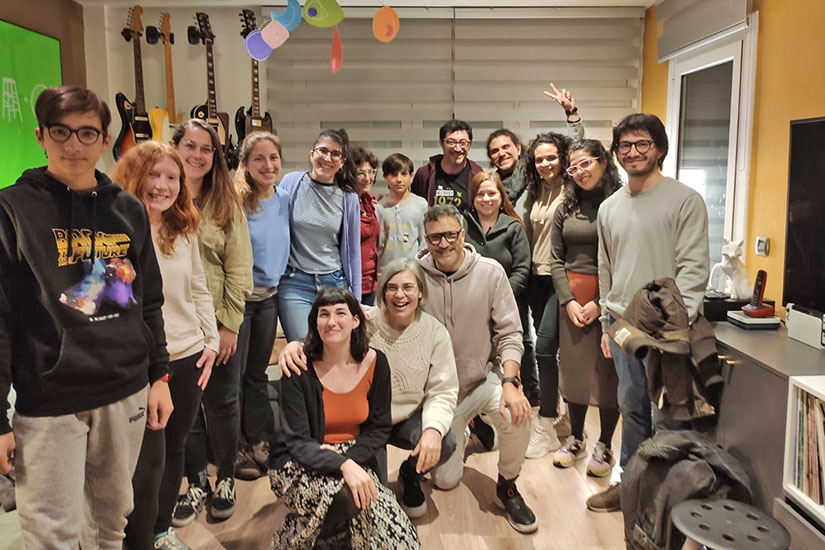Resources for the introduction of SGI-Spain’s discussion meetings
Nichiren and his followers, who chant Nam-myoho-renge-kyo, are just such bodhisattvas who emerge from the earth.
↳ OTT, page. 233. The Record of the Orally Transmitted Teachings is a collection of Nichiren Daishonin’s oral teachings on the Lotus Sutra delivered at Minobu, where he established himself in May 1274 until 8 September 1282, a few weeks before his death. These teachings were recorded and compiled in two volumes by his disciple and successor Nikko Shonin.
We celebrate May 3 as Soka Gakkai Day, our starting point. Each year, on this anniversary, we of the Soka Gakkai, united by the bonds of mentor and disciple, reaffirm our mission as Bodhisattvas of the Earth and renew our great vow for kosen-rufu. (…)
.
One of the major themes of the essential teaching (latter 14 chapters) of the Lotus Sutra is, Who will propagate the Mystic Law after Shakyamuni’s death and lead all people to enlightenment in the Latter Day of the Law in his stead?
.
This pivotal role falls to the Bodhisattvas of the Earth. (…) In Buddhism, the Law is always fundamental. But if there is no person to practice and spread it, the Law will neither benefit people nor flourish. As the Daishonin writes: “The Law does not spread by itself: because people propagate it, both the people and the Law are respectworthy.”[1] (…)
.
The Bodhisattvas of the Earth described in the Lotus Sutra are those who, while grappling with their own problems, voluntarily and without pretense leap in among the people of this evil age and strive to encourage and guide them to happiness. (…)
.
We, too, possess all of the Ten Worlds. Even should we find ourselves in a state of hellish suffering, as long as we remain undefeated, continue to chant Nam-myoho-renge-kyo wholeheartedly, and strive with all our might, we can fulfill our mission as Bodhisattvas of the Earth. We have no need for any pretense. We can strive just as we are. Whatever our present life state or circumstances, we can use everything to help us carry out our bodhisattva practice.
.
Likewise, we all have different jobs and professions, different stations in life, different talents and personalities. In our own unique spheres and capacities, we are active in society, doing our best to help others. Our beautiful diversity—like the “cherry, plum, peach, and damson”–[2] is vibrant proof of the nobility of our lives.[3]
In a recent lecture, Daisaku Ikeda has referred to another answer The Lotus Sutra brings to the concerns about the future:
The Lotus Sutra also conveys the message of children’s nobility and dignity through the story of the Dragon King’s Daughter who was eight years old. By attaining Buddhahood just as she was, she shows that all people can attain enlightenment, and in this way allows faith in the Mystic Law to awaken in the hearts of adults who doubted this possibility before.
.
I recall a touching dialogue with former Under-Secretary-General of the United Nations, Anwarul K. Chowdhury, who was closely involved in the process that led to adopt the Convention on the Rights of the Child, in 1989, and was an active promotor of it.
.
He highlighted two aspects related to the rights of the child. The first one was “the basic philosophy that children possess rights that adults must recognize;” and the second “the fundamental importance of asking children about adult actions that may have an immediate or future consequence in their lives.[4]
.
This means to treat children with supreme respect as people, allow their opinions to surface in such a way that they coincide with their development phase, bear in mind their thoughts, try to understand them and answer them adequately. In other words, it means to establish a dialogue relationship with them.
.
These types of conversations with children and adolescents at home and nearby surroundings stimulate in them and in adults the capacity to communicate themselves with others and to establish positive human relationships. I believe this will allow us to build more peaceful communities and societies.[5]

This discussion group in Barcelona embodied in its recent meeting the youthful 16 March spirit as well as, by taking pride in its name, the spirit of the 5 May –the hope of the future. Congratulations!
Mailbox: prensa@ediciones-civilizacionglobal.com
Continue reading the article addressed to the «Young phoenixes», which is the second part of this section.
[1] ↑ Extract from Hyaku Rokka Sho (The One Hundred and Six Comparisons), writing not included in WND-1 nor WND-2. Please see GZ (new edition), page 2200, and GZ, page 856.
[2] ↑ Please see OTT, page 200.
[3] ↑ Please see the section «Estudio» in this issue.
[4] ↑ CHOWDHURY, Anwarul K. y Daisaku IKEDA: Creating the Culture of Peace, Londres: I. B. Tauris, 2020, page. 86. (Tentative translation)
[5] ↑ Please see the section «Punto de partida» in Civilización Global, number 210, October 2022.

